"I am." On the flux of the artistic self in the works of Birgit Jürgenssen
“In reality, I’m actually quite different; it’s just that I so seldom get around to it.” Ödön von Horváth
“… though never changing, ever seems to be Another” Paul Verlaine
“How Does One Experience Oneself in the Other, the Other in Oneself ?” Birgit Jürgenssen 1
In Birgit Jürgenssen’s oeuvre, there are two works which, although they both assume a Self, could not possibly be more different from one another. The reason for this evident difference lies in the presence and absence of the artist herself. In a photograph from 1976, she presses her face and palms against a pane of glass, upon which is written, “Ich möchte hier raus!” (“I want out of here!” (ph17)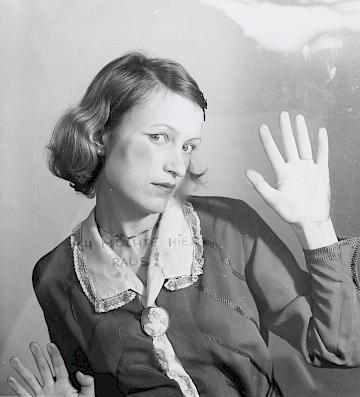 ). In another work, created nineteen years later, the artist is not visually present; what remains is her handwriting, her cultural index.Written in chalk on a small blackboard are the words “I am.” (s46)
). In another work, created nineteen years later, the artist is not visually present; what remains is her handwriting, her cultural index.Written in chalk on a small blackboard are the words “I am.” (s46)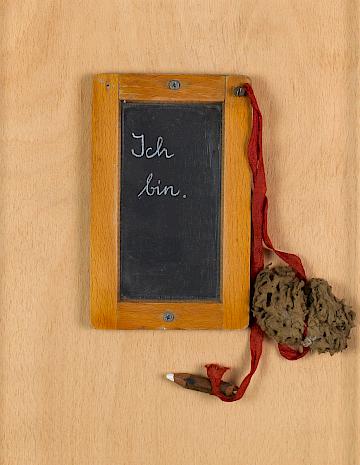 . Here, we have two fundamentally different concepts of the self, concepts which allow us to perceive the transformation that takes place in her art. Even considering the length of time (two decades) that lay between these two works’ creation, taking a closer look at how the definition of the self was transformed over the course of Jürgenssen’s oeuvre—and dividing the interplay of these differences and repetitions into the three stages of protest, transgression, and self-affirmation—we would still not have said all there is to say about the richness of her oeuvre. But it would be a start. mehr
. Here, we have two fundamentally different concepts of the self, concepts which allow us to perceive the transformation that takes place in her art. Even considering the length of time (two decades) that lay between these two works’ creation, taking a closer look at how the definition of the self was transformed over the course of Jürgenssen’s oeuvre—and dividing the interplay of these differences and repetitions into the three stages of protest, transgression, and self-affirmation—we would still not have said all there is to say about the richness of her oeuvre. But it would be a start. mehr
BOURGEOIS ORDER / PATRIARCHY
In Jürgenssen’s library there is a French textbook dating from around 1900 which used to belong to her mother. Her mother’s name has been crossed out and next to it, written in a child’s hand, are the words, “Birgit Jürgenssen. 2.Klasse” (“Birgit Jürgenssen.Grade 2”). Obviously, the artist used this textbook while attending school in the mid-nineteen-fifties. It is likely that the illustrations, which made it easier to memorize the vocabulary words, appealed to her. However, the actual study method is not as interesting as the content she subliminally absorbed. In the chapter entitled “Le Salon”, we see a scene which represents the typical bourgeois order. Le père sits at his desk, la mère is sewing, and l’enfant plays the piano—it could not be any more perfect than this. In accordance with early twentieth-century progressive thought, we see the manifestation—even in this private sphere—of an achievement-oriented code of behavior, which demands certain types of gender-specific postures. Whereas the father and child have relatively relaxed backs, the mother, of course, sits at her work with a ramrod-straight spine, in her function as a role model for other housewives. Each person relates only to him or herself; none of them turns toward the others, the atmosphere is full of a speechless sadness, and even the sound of the piano brings no cheer. A couple of pages later,we are taught that the housewife’s actual workplace is at the stove, in la cuisine (ill. p. 16). 2
In 1975, at the height of “first-wave” feminism, Jürgenssen created a striking object, the Hausfrauen-Küchenschürze (Housewives’ Kitchen Apron, (s51)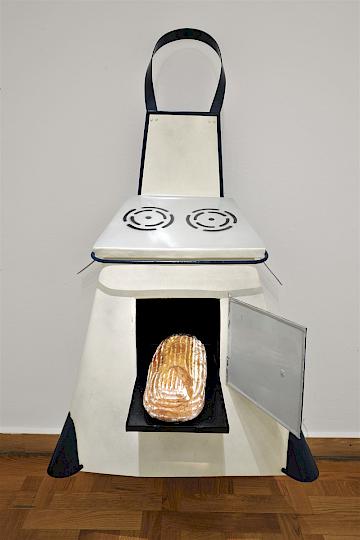 ). It depicted a stove, and that same year, it was shown at an exhibition curated by Valie Export, MAGNA—Feminismus: Kunst und Kreativität (MAGNA—Feminism: Art and Creativity, ill. p. 19). Jürgenssen, dressed as a housewife, hangs the stove around her neck so that it covers most of her torso, showing that she bears the heavy burden of the one-dimensional role of the housewife assigned by the patriarchy to women. She deliberately photographed herself with the object both frontally and in profile, thereafter assembling the photographs into a diptych. The stove hanging on her body can also be read as a metaphor for pregnancy, while the loaf of bread sticking out of the oven door might be regarded as a phallic allusion. The anachronistic shape of the stove probably reflects the age of the school textbook, but by isolating the person and the object from their social surroundings, placing them in front of a neutral background, the artist transposes the supposedly idyllic atmosphere of the bourgeois household into something like a mug shot aesthetic. The woman and the functional object, resembling a corset which seems to be growing out of her body, are mercilessly exposed to view.
). It depicted a stove, and that same year, it was shown at an exhibition curated by Valie Export, MAGNA—Feminismus: Kunst und Kreativität (MAGNA—Feminism: Art and Creativity, ill. p. 19). Jürgenssen, dressed as a housewife, hangs the stove around her neck so that it covers most of her torso, showing that she bears the heavy burden of the one-dimensional role of the housewife assigned by the patriarchy to women. She deliberately photographed herself with the object both frontally and in profile, thereafter assembling the photographs into a diptych. The stove hanging on her body can also be read as a metaphor for pregnancy, while the loaf of bread sticking out of the oven door might be regarded as a phallic allusion. The anachronistic shape of the stove probably reflects the age of the school textbook, but by isolating the person and the object from their social surroundings, placing them in front of a neutral background, the artist transposes the supposedly idyllic atmosphere of the bourgeois household into something like a mug shot aesthetic. The woman and the functional object, resembling a corset which seems to be growing out of her body, are mercilessly exposed to view.
In researching Jürgenssen’s archive, it becomes clear that the artist enjoyed collecting a great many things. She harbored a passion for various kinds of paper (occasionally having paper sent from Japan), loved books, collected art magazines, and frequently marked articles or illustrations with little notes. In an interview with Doris Linda Psenicnik, she discussed her work methods, explaining that she collected items that inspired her. Clearly, the French textbook was one of these items.We can see how important it was to the artist to communicate the ideological and aesthetic connection between the neatly organized, bourgeois world of her textbook, and her later work, the Hausfrauen-Küchenschürze, because the artist deliberately placed both images next to each other in the exhibition catalogue she designed, Früher oder Später (Sooner or Later, 1998). 3 By juxtaposing the two images, Jürgenssen allows us some insight into the mentality of the milieu which she inhabited as a child. A photograph of her and her classmates from the Notre Dame de Sion School provides equally good evidence of the compulsory discipline and conformity of the times.
The drawing Mit der Bahn Heute In Eine Bessere Zukunft (Taking the Train Today to a Better Future, 1973, (z137)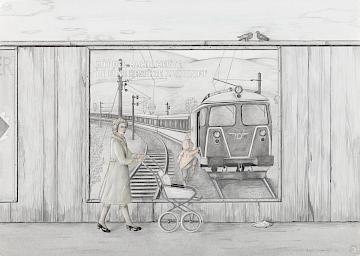 ) can be read as an ironic response to this kind of oppressively confining sociocultural environment. A child takes advantage of the brief moment in which its mother has turned away her controlling gaze, to leap out of the stroller and into the future. While it seems as if the child has just barely managed to jump onto the train, which promises another, supposedly better world, the mother doesn’t even bother to look towards freedom. Doing so no longer makes any sense; she has long ago given up her belief in freedom, and so she remains stuck in her motionless pose, an expression of compliant conformity. Yet what does the promised world of the future hold for the child? Two birds on a wire might sing of it—a song of love and togetherness.
) can be read as an ironic response to this kind of oppressively confining sociocultural environment. A child takes advantage of the brief moment in which its mother has turned away her controlling gaze, to leap out of the stroller and into the future. While it seems as if the child has just barely managed to jump onto the train, which promises another, supposedly better world, the mother doesn’t even bother to look towards freedom. Doing so no longer makes any sense; she has long ago given up her belief in freedom, and so she remains stuck in her motionless pose, an expression of compliant conformity. Yet what does the promised world of the future hold for the child? Two birds on a wire might sing of it—a song of love and togetherness.
By juxtaposing adolescent domestication and hopeless conformity with a disillusioning portrayal of person and an object, the artist protests what Michel Foucault calls the calculated “microphysics of power.” In the surrealistic interplay of real-world and imaginary visual space, we encounter the same artist who humorously and imaginatively opens up another kind of space, heralding an alternative to the alienating world of the nineteen-fifties. Over the following three decades, she would depict this alternative in various ways—via pencil, colored pencil, and analog photography, but always on paper.
FATE OF THE HOUSEWIFE
A fundamental demand of nineteen-seventies’ feminismwas that the private be considered political. This led to specific issues pertaining to women being discussed in public for the first time: pregnancy, birth, motherhood, sexuality, partnership, the dictates of beauty, one’s own body, rape, unpaid housework, and child rearing and unequal pay for men and women. Many women artists took up these themes in their work: Martha Rosler produced the video performance Semiotics of the Kitchen, Renate Bertlmann humorously targeted a Hochzeitsgesellschaft (Wedding Party), and in her video Representational Painting, Eleanor Antin questioned the normative logic behind wearing make-up and brassieres. Despite sharing common solutions, there existed—as in any political movement—different positions. 4
In keeping with certain restrictive ideas of what an emancipated woman should be or do, feminists often reproached Jürgenssen for dressing too fashionably and even using of make-up. In this context, her deliberate use of lipstick to write on her back the statement Jeder hat seine eigene Ansicht (Everyone Has His Own Point of View, (ph16)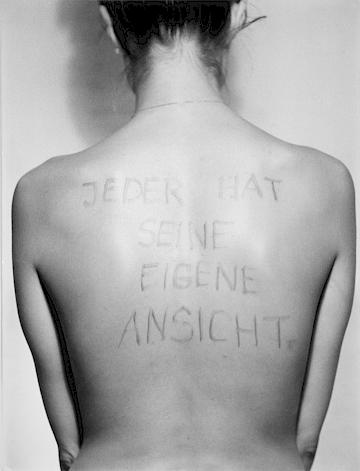 ) can be interpreted as Jürgenssen’s ironic critique of the more rigid factions of the feminist movement. In a similar way, Hannah Wilke also responded to militant feminism with her notorious poster, Marxism and Art. Beware of Fascist Feminism. 5
) can be interpreted as Jürgenssen’s ironic critique of the more rigid factions of the feminist movement. In a similar way, Hannah Wilke also responded to militant feminism with her notorious poster, Marxism and Art. Beware of Fascist Feminism. 5
Jürgenssen did a number of provocative Housewife drawings, drawings which now number among the major works of the feminist avant-garde. The theme of the drawing Fensterputzen (Window Cleaning, (z400)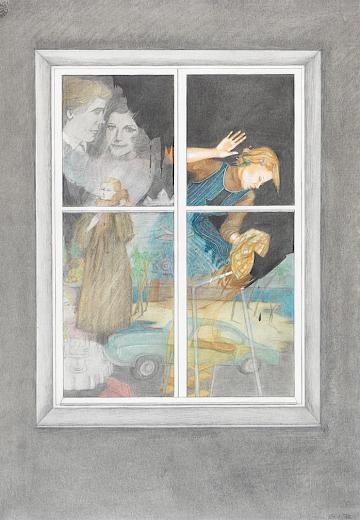 ) is the disappointingly vast gap represented by the duality between “the happiness marriage promises and the misery of everyday life.” 6 The seductive array of stereotypical desires (status symbols such as cars, vacations and fur coats) indoctrinates the housewife and fosters a kind of wishful thinking that binds her to her everyday reality. What remains is a sober everyday life—the Pflichten einer Ehefrau (Duties of a Wife, (z410)
) is the disappointingly vast gap represented by the duality between “the happiness marriage promises and the misery of everyday life.” 6 The seductive array of stereotypical desires (status symbols such as cars, vacations and fur coats) indoctrinates the housewife and fosters a kind of wishful thinking that binds her to her everyday reality. What remains is a sober everyday life—the Pflichten einer Ehefrau (Duties of a Wife, (z410) ), Bügeln (Ironing, (z963)
), Bügeln (Ironing, (z963)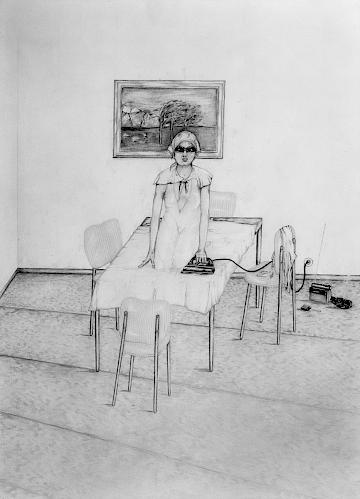 ), Bodenschrubben (Scrubbing the Floor, (z402)
), Bodenschrubben (Scrubbing the Floor, (z402)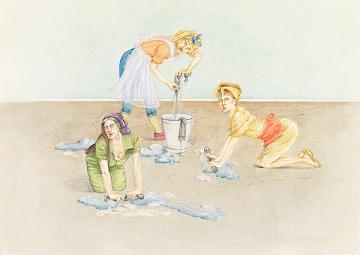 )—and, of course, putting a good face on things: when the housewife loses her smile, she proceeds to train it in front of the mirror, as in Cheese (z414)
)—and, of course, putting a good face on things: when the housewife loses her smile, she proceeds to train it in front of the mirror, as in Cheese (z414)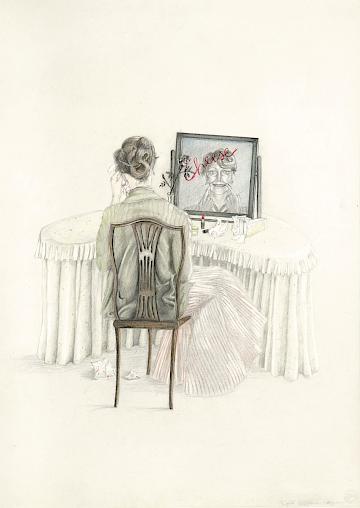 . The drawing Bügeln refers to the burden of regular housework, but it can also be understood as ametaphor for “ironing everything out”—wanting to create an idealized world in a cozy little home, while outside, the raw wind blows as shown in the framed picture behind the woman ironing. The substantive unity of the female body, clothing, and table awakens yet another thought: that by ironing, the housewife not only smoothes out her immediate surroundings, but also flattens herself in the process. Here, two spheres symbolically collide: the normal, conformist, smoothly ironed world, and the world of folds, in which manifold aspects of individuality can indeed succeed in unfolding.
. The drawing Bügeln refers to the burden of regular housework, but it can also be understood as ametaphor for “ironing everything out”—wanting to create an idealized world in a cozy little home, while outside, the raw wind blows as shown in the framed picture behind the woman ironing. The substantive unity of the female body, clothing, and table awakens yet another thought: that by ironing, the housewife not only smoothes out her immediate surroundings, but also flattens herself in the process. Here, two spheres symbolically collide: the normal, conformist, smoothly ironed world, and the world of folds, in which manifold aspects of individuality can indeed succeed in unfolding.
Accordingly, because the life of a “housewife” is exclusionary—a person’s existence is reduced to nothing but housework—it also means that the housewife loses the opportunity to let her personality unfold. This loss is also visualized in another Hausfrauen drawing (z966) . One of the housewife’s everyday tools, a stained dishcloth, functions as its own space in the picture; inside of it, the torso of a woman is frozen into a bust. A grid pattern camouflages the woman’s face, throat and entire torso. Here, the woman’s skin and dress are subtly covered with a standardized, uniform, center-less, cell-shaped surface, suggesting that the mode of living known as “housewife” offers no life beyond the implied profession. The wrinkle-free world joins with the world of imprisonment. A remarkable thing about this drawing is that it lends anthropomorphic and narrative qualities to the grid, in its capacity as an avant-garde art practice of the modern era. Art historian Rosalind Krauss accuses the “grid”—defined as “will to silence”—of lapsing into its “hostility to … narrative,” its “anti-referential character.” 7
. One of the housewife’s everyday tools, a stained dishcloth, functions as its own space in the picture; inside of it, the torso of a woman is frozen into a bust. A grid pattern camouflages the woman’s face, throat and entire torso. Here, the woman’s skin and dress are subtly covered with a standardized, uniform, center-less, cell-shaped surface, suggesting that the mode of living known as “housewife” offers no life beyond the implied profession. The wrinkle-free world joins with the world of imprisonment. A remarkable thing about this drawing is that it lends anthropomorphic and narrative qualities to the grid, in its capacity as an avant-garde art practice of the modern era. Art historian Rosalind Krauss accuses the “grid”—defined as “will to silence”—of lapsing into its “hostility to … narrative,” its “anti-referential character.” 7
Let us take into consideration the fact that, unlike wage labor, housework is unpaid, for which reason the devaluation of women in the household can be viewed as being commensurate with their generally degraded position. In his analysis of Jürgenssen’s Hausfrauen drawings, Peter Weibel writes, “The female body is … a territory of male hegemony and therefore a field for colonialization. … The drawings show that femininity as construed by society is a mark of the suffering that has occurred under a centuries-old dictatorship.” 8 One can easily imagine the presence of lynching fantasies here and there; in Bodenschrubben the male figure is parodically used as a Waschlappen [literally, a washcloth, but Waschlappen is also slang for a weak man]. The process of taking words or sayings literally and then visualizing them in an ironic manner forms a central topos in Jürgenssen’s oeuvre. In 1990, a group of women artists known as DIE DAMEN (The Ladies) re-staged the scene from Bodenschrubben in Jürgenssen’s studio.
The duties of a “good” housewife, however, include not only cooking, child rearing, and cleaning, but above all “obedience.” Even as late as 1955, the British magazine Housekeeping Monthly published guidelines that read like a ghastly moral codex. “Do not doubt your husband’s judgment. Remember: he is the head of the household. You have no right to question him.” 9Simone de Beauvoir had already opposed this kind of hierarchy and discrimination in 1949, in her seminal work The Second Sex: “One is not born a woman, one becomes one.” The philosopher revealed women’s position as a social construct, specifying that “Marriage is the fate that society usually has in store for a woman.” 10
An excellent example of this is the statement of an assistant at the Hochschule für Angewandte Kunst (today’s University of Applied Arts) in Vienna, where Jürgenssen studied printed graphics from 1967 to 1971: “Oh, Miss Jürgenssen, why are you dragging those heavy lithography stones around? You’re just going to get married soon, anyway.” 11 Jürgenssen gave herself the right to challenge the construct of “fate = patriarchy.” In those days, being a woman and being an artist were seldom synonymous. Out of Jürgenssen’s works leapt the spark of that enlightening attitude described by Foucault in 1978 as the Western project of critical analysis, namely, the “art of not being governed like that.” 12 Looking back, the artist explained, “I wanted to show the common prejudices against women, the role models that society ascribed to them, the ones with which I was always confronted—and I wanted to depict everyday misunderstandings.” 13 Her vocabulary of criticism is diverse. Emotions were put down on paper, either directly or in a more distanced way, and always with a wealth of details: macabre and desperate, provocative and aggressive, ironic and subversive. Just as in Lewis Carroll’s classic, Alice in Wonderland, which the artist admired, the proportions are deliberately inverted: the Hausfrau (Housewife, (z401)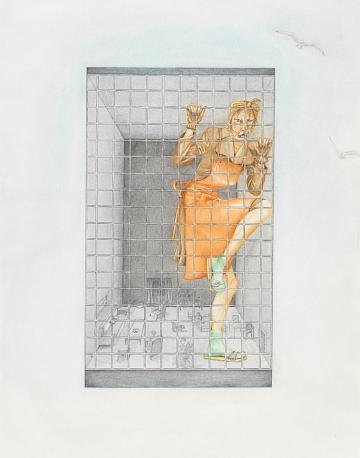 ) turns into an oversized tigress. The small-minded, shrunken home proves to be a prison, and so she shakes the bars in rage; not coincidentally, the bars form a grid. On the other side of the boundary, one sees two birds in flight—yet another allegory of freedom.
) turns into an oversized tigress. The small-minded, shrunken home proves to be a prison, and so she shakes the bars in rage; not coincidentally, the bars form a grid. On the other side of the boundary, one sees two birds in flight—yet another allegory of freedom.
“MYSELF AS BONSAI”
Jürgenssen was possessed of a markedly diagnostic intuition. She recognized the social stereotypes and “dispositifs” which women faced during the nineteen-seventies, and she also experienced them herself. The year 1976 saw her produce nightmarish drawings that speak of suffocating imprisonment and physical punishment. In Stütze (Support, (z98) ), we see a woman with a rope around her neck, bound to a post. This kind of restraining mechanism can be read as a macabre reference to the family, which, though it may be supportive, also oppressively binds the female body and does not let it go. In Autotransfusion (z90)
), we see a woman with a rope around her neck, bound to a post. This kind of restraining mechanism can be read as a macabre reference to the family, which, though it may be supportive, also oppressively binds the female body and does not let it go. In Autotransfusion (z90) , a woman’s entire body, including her head, is bandaged; she can neither see nor speak, and her body is most probably injured all over. In Stiefelknecht (Bootjack, (z417)
, a woman’s entire body, including her head, is bandaged; she can neither see nor speak, and her body is most probably injured all over. In Stiefelknecht (Bootjack, (z417) ) the woman is sadistically denied the freedom to move, with her feet, arms, and neck being bound. Whereas Hegel, in his dialectic analysis of the master-servant relationship, credits the servant with a certain amount of power (insofar as the master is also dependent upon the servant), in this case the woman is not even granted this “remnant” of autonomy. Rather, she is degraded to a merely functional thing: she can only stand submissively at attention.
) the woman is sadistically denied the freedom to move, with her feet, arms, and neck being bound. Whereas Hegel, in his dialectic analysis of the master-servant relationship, credits the servant with a certain amount of power (insofar as the master is also dependent upon the servant), in this case the woman is not even granted this “remnant” of autonomy. Rather, she is degraded to a merely functional thing: she can only stand submissively at attention.
In Schuhmaske (Shoe Mask, (z406)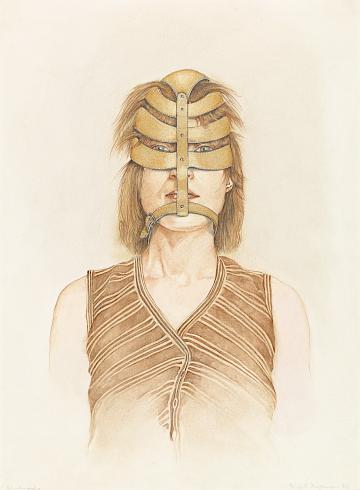 , the woman is further debased; a kind of muzzle has been put over her head, so that she has just enough room to see out between the straps but is denied speech, denied her own ability to express herself. The woman beneath the Schuhmaske stoically endures this, as if this were an inevitable fate. Her position seems almost autistic, paralyzed. Has she already lost all her feelings?
, the woman is further debased; a kind of muzzle has been put over her head, so that she has just enough room to see out between the straps but is denied speech, denied her own ability to express herself. The woman beneath the Schuhmaske stoically endures this, as if this were an inevitable fate. Her position seems almost autistic, paralyzed. Has she already lost all her feelings?
As mentioned above, these four drawings, done in a nuanced, brownish-red hue, were created in 1976. It is apparent that the women in these images resemble the artist, for which reason these works could with some justification be viewed as self-portraits. This is particularly evident in Schuhmaske. It is modeled after an earlier portrait (ph671)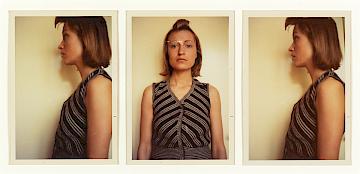 of Jürgenssen, whose hair length and posture are the same, and who is dressed in the same sleeveless woolen vest. The autobiographical references resonating in these drawings point to a kind of self-identity that makes the mistreated body the focus of reflection. A note by the artist underscores this focus: “Myself as BONSAI.” In parentheses, she adds, “a tree that is kept to a low height through special treatment.” 14 Tied up. Degraded to a motionless thing. Bandaged to the point where she cannot breathe. Masked to the point of being mute. Cut, shaped, and wired so that she remains as small as a bonsai tree. During that year, Jürgenssen revealingly marked off the coordinates of repressive “cultural” sanctions. To pick up on one of Judith Butler’s ideas: society’s norms and power mechanisms materialize on the body of the woman artist. 15
of Jürgenssen, whose hair length and posture are the same, and who is dressed in the same sleeveless woolen vest. The autobiographical references resonating in these drawings point to a kind of self-identity that makes the mistreated body the focus of reflection. A note by the artist underscores this focus: “Myself as BONSAI.” In parentheses, she adds, “a tree that is kept to a low height through special treatment.” 14 Tied up. Degraded to a motionless thing. Bandaged to the point where she cannot breathe. Masked to the point of being mute. Cut, shaped, and wired so that she remains as small as a bonsai tree. During that year, Jürgenssen revealingly marked off the coordinates of repressive “cultural” sanctions. To pick up on one of Judith Butler’s ideas: society’s norms and power mechanisms materialize on the body of the woman artist. 15
BOUNDARY / TRANSGRESSION
It is probably not surprising that, in that same year of 1976, the artist presented a scene involving the transgression of limitations.The photograph, Ich möchte hier raus! (ph16) is one of Jürgenssen’s most popular works, possibly because every one of us has felt the same way at one time or another. Neatly and smartly dressed, with a white lace collar and brooch, she presses her face so hard against a glass wall that her cheek leaves a mark and her breath condenses on the glass. In a 2008 exhibition at Munich’s Pinakothek der Moderne entitled female trouble and curated by Inka Graeve Ingelmann, a few visitors wondered why these words were written on the pane of glass. “It couldn’t have been the woman in the photo, because otherwise the letters would be reversed,” wrote Rainer Burkard, for example. 16 Wrong. Whenever Jürgenssen posed for the camera, she did so alone in her studio, and the delayed-action shutter release cable always went with her everywhere—as can be seen, for instance, in Totentanz mit Mädchen (Danse Macabre with Girl, (ph4, ph3, ph8, ph5, ph10, ph9, ph1, ph6, ph12)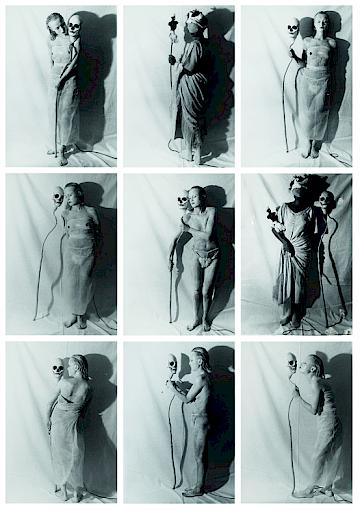 ). Right after graduating from art school, the artist set up a darkroom in her studio, and for three decades she took photographs with an analog camera. She was fond of “experimenting” in various ways with the conventional photographic process.17 A contact print in the artist’s archives now allows us to see that the scene was first inverted, because during the performance in the studio, the artist’s head and eyes are turned to the left, while in the original photograph, the person is looking to the right, in accordance with the way we read. Moreover, the writing on this contact print is also reversed.The artist evidently turned the negative around and then made the exposure on photographic paper. Interestingly enough, the inversion that takes place on the level of the photographic material is followed by a similar inversion on the contextual level, since, considering the alarming sentence “I want out of here!” the artist’s facial expression is quite cool and distanced, so that one wonders about it. There exists a second photograph (ph1739)
). Right after graduating from art school, the artist set up a darkroom in her studio, and for three decades she took photographs with an analog camera. She was fond of “experimenting” in various ways with the conventional photographic process.17 A contact print in the artist’s archives now allows us to see that the scene was first inverted, because during the performance in the studio, the artist’s head and eyes are turned to the left, while in the original photograph, the person is looking to the right, in accordance with the way we read. Moreover, the writing on this contact print is also reversed.The artist evidently turned the negative around and then made the exposure on photographic paper. Interestingly enough, the inversion that takes place on the level of the photographic material is followed by a similar inversion on the contextual level, since, considering the alarming sentence “I want out of here!” the artist’s facial expression is quite cool and distanced, so that one wonders about it. There exists a second photograph (ph1739)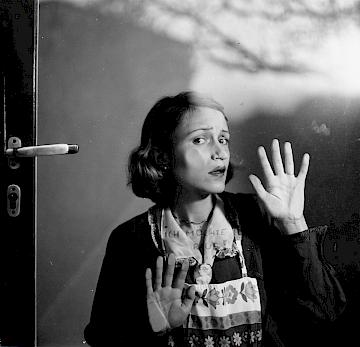 of the same scene with the woman pressing even harder against the glass so that her cheek—and this time even the tip of her nose—leaves a mark. She looks more upset, more desperate, more despondent. The cry for help “I want out!” is defined only by the subject, without any reference to her social surroundings, whereas the apron—as an insignia of housework—more precisely defines what kind of wife (see the ring) is being featured. This scene can dispense with the word “here,” because the door handle and frame clearly indicate an “in front” and a “behind,” and therefore mark a specific boundary which has to be crossed during the prison break. The contact print mentioned above features yet a third version of the same scene: this time the woman is wearing not a dress, but a sweater with a leopard-skin print. Her hands are shaped like cat paws. Her eyes, pupils, and mouth are wide open, her hair stands up straight, and the terror that seems to be shooting through this woman’s veins can be clearly sensed. In these three stages, Jürgenssen unfolds variations on certain emotional states experienced by the self, thus presenting us with a contemporary éducation sentimentale of sorts, which certainly also implies various class-specific nuances, from a sense of upper bourgeois distance to middle-class desperation.
of the same scene with the woman pressing even harder against the glass so that her cheek—and this time even the tip of her nose—leaves a mark. She looks more upset, more desperate, more despondent. The cry for help “I want out!” is defined only by the subject, without any reference to her social surroundings, whereas the apron—as an insignia of housework—more precisely defines what kind of wife (see the ring) is being featured. This scene can dispense with the word “here,” because the door handle and frame clearly indicate an “in front” and a “behind,” and therefore mark a specific boundary which has to be crossed during the prison break. The contact print mentioned above features yet a third version of the same scene: this time the woman is wearing not a dress, but a sweater with a leopard-skin print. Her hands are shaped like cat paws. Her eyes, pupils, and mouth are wide open, her hair stands up straight, and the terror that seems to be shooting through this woman’s veins can be clearly sensed. In these three stages, Jürgenssen unfolds variations on certain emotional states experienced by the self, thus presenting us with a contemporary éducation sentimentale of sorts, which certainly also implies various class-specific nuances, from a sense of upper bourgeois distance to middle-class desperation.
“To me, performance means having the opportunity,” explains Jürgenssen, “to put a concrete issue into an artistic form.” 18 The performative variations of Ich möchte hier raus! shed light on the existential urgency involved in the transgression of boundaries. But where does one transgress to? And to what purpose? What does the space beyond that boundary look like? In her many notebooks, the artist tirelessly wrote, sketched, noted ideas for works, wrote poems, devised puns and copied quotations out of books—such as this one by ethnologist Hans Peter Duerr: “Only someone who climbs over the fence understands the meaning of the things inside the fence.” 19 In a letter (composed not coincidentally on International Women’s Day), Jürgenssen wrote, “The question of self-identity today is no longer Who am I?, but rather, Where am I? … Gender-specific identity arises out of the space that people create within which to exist.” 20 In the “act of transgression,” therefore, lies the attempt to cast off unloved identities (housewife, wife, cleaning woman, the abused body), to affirm the negation of “false” identities, and, in so doing, to conquer a space that has been defined by oneself.
STRONG WOMAN/WOMEN
“Be really creative, refuse your role,” wrote Jürgenssen in one of her notebooks. The potential for protest and independence, however, had begun to unfold even before she staged her border crossing. With youthful élan, her early drawings examine self-defined subjectivity, whose horizon is characterized by “independence,” “self-affirmation” and “self-realization”. A woman takes herself beim Schopf [literally, “seizes herself by the scruff of her neck” (or by the hair), thus taking her fate into her own hands]. Or she might turn into a superheroine such as Batwoman. Jürgenssen, however, did not simply stick to depicting self-confident woman figures who know how to break “all chains”. Instead, she also aimed her social criticism at the role of the man as the “hero of history.” This seemed to require a change of perspective. Strong femininity is ironically presented as the counterpart to the myth of the strong man. “Empress Augustina” is honored. Like the Roman Emperor Augustus, Augustina is given an armored breastplate which shows, for the first time, her everyday heroic deeds and the everyday battles she has won (z107) . Here, the artist criticizes a chauvinist historiography that is content merely to compile lists of rulers and battles. The drawing picks up on a characteristic of the Brechtian critique of history. In his famous poem, “A Worker Reads History,” Bertolt Brecht’s worker asks, “Young Alexander conquered India. He alone? Caesar beat the Gauls. Was there not even a cook in his army? Philip of Spain wept as his fleet was sunk and destroyed. Were there no other tears?” 21Although the poet is right to reclaim the voice of the people in conventional historiography, Jürgenssen goes a step further, demanding the missing “woman’s voice.” It was not just the legendary politician, but also his wife, Mrs. Churchill (z716)
. Here, the artist criticizes a chauvinist historiography that is content merely to compile lists of rulers and battles. The drawing picks up on a characteristic of the Brechtian critique of history. In his famous poem, “A Worker Reads History,” Bertolt Brecht’s worker asks, “Young Alexander conquered India. He alone? Caesar beat the Gauls. Was there not even a cook in his army? Philip of Spain wept as his fleet was sunk and destroyed. Were there no other tears?” 21Although the poet is right to reclaim the voice of the people in conventional historiography, Jürgenssen goes a step further, demanding the missing “woman’s voice.” It was not just the legendary politician, but also his wife, Mrs. Churchill (z716)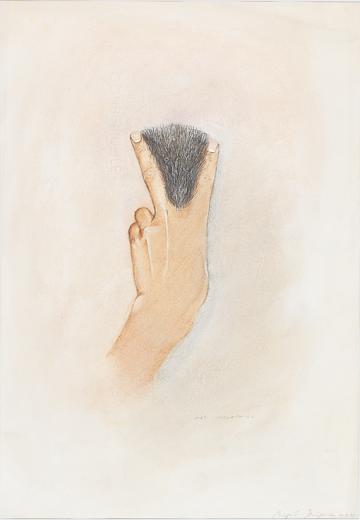 , who had reason to raise her hand in the victory sign.Which battle did she think she had won? The battle for emancipation? 22
, who had reason to raise her hand in the victory sign.Which battle did she think she had won? The battle for emancipation? 22
The drawing Emanzipation (z109) humorously depicts a typical gesture of masculine strength—flexing the biceps—transformed into a nurturing breast, substituting a symbol of “male strength” with a newly created image of “female strength.” Through this drawing, the artist honors something that is missing from our language: there is no female counterpart for the term “virility” (there is also a photograph version of Emanzipation, (ph23)
humorously depicts a typical gesture of masculine strength—flexing the biceps—transformed into a nurturing breast, substituting a symbol of “male strength” with a newly created image of “female strength.” Through this drawing, the artist honors something that is missing from our language: there is no female counterpart for the term “virility” (there is also a photograph version of Emanzipation, (ph23) ). For Jürgenssen, self-irony was “a form of autobiographical strategy,” as she explained in an interview, “that makes it easier to convey subversive and deconstructive potential.”This kind of self-irony helped her to maintain a sense of “distance” toward the “strongly clichéd roles” with which she had grown up. 23 So, in her oeuvre, self-irony takes on the function of an effective “antidote.” In many of her works, therefore, stereotypical roles are subverted through self-irony, as in the photograph Gretchen von Faust (Gretchen from Faust,(ph1541)
). For Jürgenssen, self-irony was “a form of autobiographical strategy,” as she explained in an interview, “that makes it easier to convey subversive and deconstructive potential.”This kind of self-irony helped her to maintain a sense of “distance” toward the “strongly clichéd roles” with which she had grown up. 23 So, in her oeuvre, self-irony takes on the function of an effective “antidote.” In many of her works, therefore, stereotypical roles are subverted through self-irony, as in the photograph Gretchen von Faust (Gretchen from Faust,(ph1541)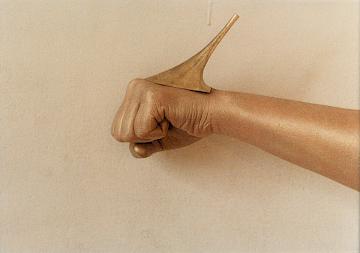 ), where the “weaker sex” is pointedly transformed into a “strong” one. The heel of a woman’s shoe balanced on a fist mutates into a sharp weapon. Is Gretchen’s fateful tragedy being inverted here? Is a gentle, reportedly lost Gretchen being transformed into a militant woman who, despite resistance from society, knows how to rout the man who corrupted her? Earlier improvisations also show the heel of a shoe being used to lend additional strength to the biceps (ph1655)
), where the “weaker sex” is pointedly transformed into a “strong” one. The heel of a woman’s shoe balanced on a fist mutates into a sharp weapon. Is Gretchen’s fateful tragedy being inverted here? Is a gentle, reportedly lost Gretchen being transformed into a militant woman who, despite resistance from society, knows how to rout the man who corrupted her? Earlier improvisations also show the heel of a shoe being used to lend additional strength to the biceps (ph1655) .
.
In April of 1974, Jürgenssen asked DuMont publishers to produce a comprehensive catalogue of her work. “Woman is so often the object of art,” she writes in her letter of request. “She is seldom and only reluctantly permitted to speak or portray herself . . . I would like to have the chance to be able to compare myself not just to my male colleagues, but also to my female colleagues.” She found this kind of female collegiality in the artists Meret Oppenheim and Louise Bourgeois. Jürgenssen thought that Oppenheim’s and Bourgeois’s works were “more poetic, less direct, and more subversive” 24 than those of other women artists. In the nineteenseventies’ art world, it was not easy for an up-and-coming woman artist to orient herself towards a particular type of woman artist—nor was it easy for her to distinguish herself from them, either. The legacy of modernism was intractable. The habitual equation of “man = artist = painter = genius” endured into the postmodern era.We must only think of Pablo Picasso or the gritty, Jackson Pollock type, whose James Dean-like airs influenced painting beyond just the American post-war scene. 25 In the literary and cinematic worlds, it seems that it was easier for an independent woman to succeed, even though stereotypes—such as the femme fatale—were also created here. In the novels of Raymond Chandler, as well as the films featuring the actresses Marlene Dietrich and Mae West, Jürgenssen liked most of all the dialogues between women and men. In a conversation, the artist explained that, in these films, the women were on a “relatively equal” footing with men, at least on the linguistic level, thanks to their “puns, irony, and clever repartee.” 26 West was known for having rewritten entire screenplays, as well as authoring her own, and many of her famously eloquent lines are still widely quoted. Jürgenssen called one of her drawings Mae and Me, a title that practically puts the two on an equal level, thereby showing how much she appreciated the charismatic film actress, of whom she said admiringly, “She is so strong and has such presence. She has intelligence and a sense of humor. All things I would like to be characteristics of my work.” 27 The year she staged her “boundary transgressions,” Jürgenssen even met the actress in person, since West came to Vienna in 1976 at the invitation of the Film Museum. 28 In a preliminary study for a triptych Jürgenssen also drew a parallel between West and the Greek goddess Athena .
A woman of independent character, going through life on her own, knows—as West did— how to put her own ideas and imaginings down on paper by herself; she knows how to master her own problems, and this quality is indicated in the drawing Das Match das trag ich mit mir selber aus (I’ll play the match with myself, (z30)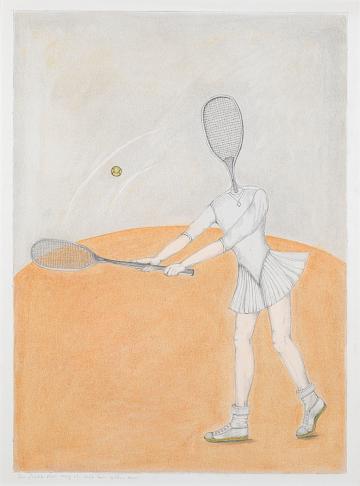 ); this notion is certainly part of the way that Jürgenssen thought of herself as an artist. She confirmed this position humorously with a postcard that she sent to Vienna when she was in Sydney to show her work at the Biennial there in 1984. The postcard features a picture of Australian actress Annette Kellerman in a self-confident pose. Above the picture of the woman and the bird, she wrote, “That’s me in Sydney”. Since Jürgenssen’s thinking and work were anything but “linear,” we can view this distant echo of the familiar “me” in accordance with her self-ironic manner, as referring to the woman and/or as referring to the bird. This is a shifting “me,” open to both identities. Her move toward alternative identities is also expressed in a notebook entry, which reads, “Phone from mother. I’ll always be other.” In Meret Oppenheim, Jürgenssen saw something of an imaginary artist-mother who affirmed and further fueled her imagination.
); this notion is certainly part of the way that Jürgenssen thought of herself as an artist. She confirmed this position humorously with a postcard that she sent to Vienna when she was in Sydney to show her work at the Biennial there in 1984. The postcard features a picture of Australian actress Annette Kellerman in a self-confident pose. Above the picture of the woman and the bird, she wrote, “That’s me in Sydney”. Since Jürgenssen’s thinking and work were anything but “linear,” we can view this distant echo of the familiar “me” in accordance with her self-ironic manner, as referring to the woman and/or as referring to the bird. This is a shifting “me,” open to both identities. Her move toward alternative identities is also expressed in a notebook entry, which reads, “Phone from mother. I’ll always be other.” In Meret Oppenheim, Jürgenssen saw something of an imaginary artist-mother who affirmed and further fueled her imagination.
DIFFERENCE AND REPETITION
At the age of eight, Jürgenssen began copying pictures out of a Picasso book. 29 These drawings are all in a single school notebook. At the time, she signed a few of them “BICASSO Birgit Jürgenssen,” and on the following pages she eventually incorporated the name of the Spanish master into her own, signing “BICASSO Jürgenssen”. It is important to know here that, as a child, her nickname was “Bi.” This creative shifting of names is evidence of a child conquering an artistic space, thus inscribing itself into a “new” territory. According to Gilles Deleuze and Félix Guattari, “the signature, one’s own name is . . . not amarking created through a subject, but the constitutive marking of a realm, a dwelling.”30 This dwelling is a kind of “becoming.” Deleuze and Guattari, known for their critique of Oedipus, do not define the creative power of becoming through genealogy, for “every genealogy is imaginary.” For them, becoming always belongs “to a different order than genealogy. It comes about through alliances.”31 Even during her early years, Jürgenssen made “alliances” with Picasso, and later on she also did so with Surrealist poetry and the semiotics and structuralism, as well as with Meret Oppenheim, Louise Bourgeois, Mae West, and with the literature of Gertrude Stein, Virginia Woolf, Marguerite Duras, and Raymond Chandler.
Above all, she allied herself with the “cultural other,” within whose territory she tried to find her way to other identities. In one collage, she reconfigures her surname by getting rid of the umlaut and exchanging the double “s” for a double “n.” These seemingly minimal changes imply nothing less than a shift of her family narrative in the direction of Japanese culture, because the Japanese language has no umlauts, just open syllables ending in vowel sounds, the only exception being the letter “n.” Hence, it is practically impossible to say “-genssen,” but “-gennsen” works very well. Even though neither of these versions sounds Japanese, at least JURGENNSEN is pronounceable for Japanese-speakers. 32 The artist had become familiar with Japanese culture early on, since her great-grandmother, Olga Matsuo, was Japanese, and when returning from his trips to Japan, Jürgenssen’s father often brought home fabrics, books, kimonos, and other surprises which delighted his daughter.Her interest in Japanese culture is also indicated by the many books on Japanese art in her library. In one photograph, the artist picks up on a form of Japanese identity by using her posture and hairdo to stage an imaginary encounter between herself and a woman depicted in another photograph. Much like incorporating Picasso’s name into her own, opening up to the culturally “other” can be interpreted as a kind of deterritorialization towards a self-selected “other” space. The act of embracing other realms of reference helped constitute the artist’s self-identity. In her notebook, she writes, “I am whatever I am in relation to others.” 33
So, according to my first thesis, Jürgenssen’s creative powers always come from other self-identities which make it possible for her to introduce the interplay between difference and repetition into the supposedly homogenous self-identify. Even in an early drawing, Mein zweites “ich” (My Second “Self,” 1966), one of Jürgenssen’s alter egos ascends into the world of the imagination. Arthur Rimbaud’s famous statement, “I is another,” is echoed here; years later, the artist was to pay tribute to himin a portrait drawing on canvas. The artist referred to this notion of experiencing one’s own self in others in the title of her 1985 exhibition,Wie erfährt man sich im Anderen, das Andere in sich? (How Does One Experience Oneself in the Other, the Other in Oneself ?).
For the sake of her work, Jürgenssen also formed an intimate alliance with literature. Looking back in an interview with Felicitas Thun-Hohenstein, she explained, “My works have been created . . . out of the interplay between literature and everyday life. It was impossible for me to draw without having a piece of literature on my mind.” 34In her drawing Demaskierung (Unmasking, (z300)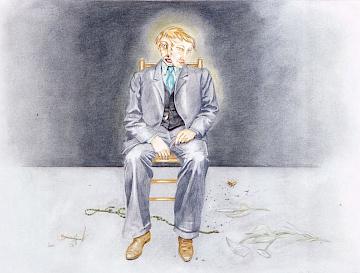 ), which tells a subtle tale of two divergent identities, we recognize Dr. Jekyll and Mr. Hyde. In a small self-portrait, done in 1978, two years after her “boundary crossing” mentioned above, the artist—with a pattern painted on her face—looks to us like a Native American (z883)
), which tells a subtle tale of two divergent identities, we recognize Dr. Jekyll and Mr. Hyde. In a small self-portrait, done in 1978, two years after her “boundary crossing” mentioned above, the artist—with a pattern painted on her face—looks to us like a Native American (z883) . This time, the literary reference remains hidden. Her notebook contains a quotation taken from Franz Kafka’s short story, The Wish to be a Red Indian: “If only one were an Indian, at the ready on a galloping horse.” Here, too, the desire for another “other” self is evinced. Yet another clue can be found in a book from her library. In the writings of Henri Michaux, a bookmark sits at a spot in his text, “Tätowierungen” (Tattoos). In this section, the French writer and artist celebrates the benefits of painting oneself. “Anything unhealthy or bestial about the skin disappears as soon as there are a couple of lines of a grid pattern on it. The face looks not so much intelligent as it does intellectual; it becomes intellectually spiritual.” At the end, however, he adds, “like any other decoration, the tattoo can allow a surface as such to emerge, but it is easier for it to make the surface disappear, just like a tapestry makes the breadth of a wall vanish. It is time, however, to make the face disappear.” 35 Now, it would certainly be excessive to trace back the progress of Jürgenssen’s artistic manifestations to Michaux’s demand alone. Nevertheless, following this path might yield something, since the portrait of the “Indian woman” was one of the last portraits in Jürgenssen’s oeuvre in which an individual face could be recognized.
. This time, the literary reference remains hidden. Her notebook contains a quotation taken from Franz Kafka’s short story, The Wish to be a Red Indian: “If only one were an Indian, at the ready on a galloping horse.” Here, too, the desire for another “other” self is evinced. Yet another clue can be found in a book from her library. In the writings of Henri Michaux, a bookmark sits at a spot in his text, “Tätowierungen” (Tattoos). In this section, the French writer and artist celebrates the benefits of painting oneself. “Anything unhealthy or bestial about the skin disappears as soon as there are a couple of lines of a grid pattern on it. The face looks not so much intelligent as it does intellectual; it becomes intellectually spiritual.” At the end, however, he adds, “like any other decoration, the tattoo can allow a surface as such to emerge, but it is easier for it to make the surface disappear, just like a tapestry makes the breadth of a wall vanish. It is time, however, to make the face disappear.” 35 Now, it would certainly be excessive to trace back the progress of Jürgenssen’s artistic manifestations to Michaux’s demand alone. Nevertheless, following this path might yield something, since the portrait of the “Indian woman” was one of the last portraits in Jürgenssen’s oeuvre in which an individual face could be recognized.
MODERNIST AND POSTMODERNIST CONCEPTS OF THE SELF
Let us look at the four portraits (ph670)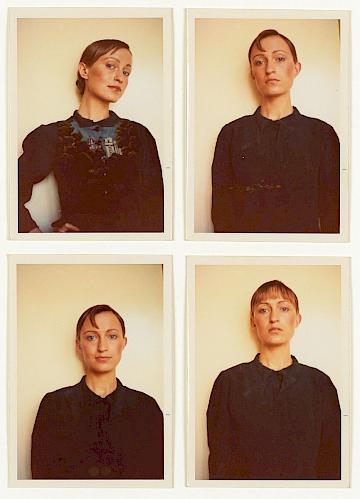 and the triptych mentioned above (ph671), as well as the diptych of 1978/79; likewise, let us recall the photographs Ich möchte hier raus! (ph16), Hausfrauen-Küchenschürze (ph1578), her presentation of the Japanese identity (fig. 33), and the portrait of the “Indian woman” (z883) just discussed. All of these works emphasize close-ups of the face. In one of Jürgenssen’s notebooks, one can read “a face is a place.” During the seventies, the face-as-place or the face-as-dwelling was very likely determined by the “concept of legibility.” In these works, the face is, in accordance with Jacques Aumont’s description, a “legible surface,” and the close-up underscores the narrative function of the face as an “agent of meaning.” 36 Other works examined here, such as the Hausfrauen drawings and the drawings of 1976 which bear a resemblance to self-portraits (such as Stütze (z98), Autotransfusion (z90), Stiefelknecht (z417) and Schuhmaske (z406); Grosses Mädchen (Big Girl) (z399)
and the triptych mentioned above (ph671), as well as the diptych of 1978/79; likewise, let us recall the photographs Ich möchte hier raus! (ph16), Hausfrauen-Küchenschürze (ph1578), her presentation of the Japanese identity (fig. 33), and the portrait of the “Indian woman” (z883) just discussed. All of these works emphasize close-ups of the face. In one of Jürgenssen’s notebooks, one can read “a face is a place.” During the seventies, the face-as-place or the face-as-dwelling was very likely determined by the “concept of legibility.” In these works, the face is, in accordance with Jacques Aumont’s description, a “legible surface,” and the close-up underscores the narrative function of the face as an “agent of meaning.” 36 Other works examined here, such as the Hausfrauen drawings and the drawings of 1976 which bear a resemblance to self-portraits (such as Stütze (z98), Autotransfusion (z90), Stiefelknecht (z417) and Schuhmaske (z406); Grosses Mädchen (Big Girl) (z399)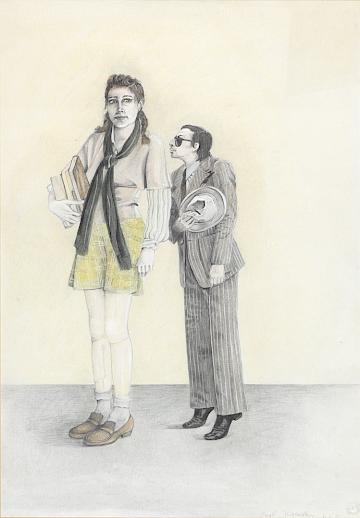 ; Lehrmädchen (The Apprentice Girl); Sich selbst beim Schopf packen (To Pull Oneself Up by the Scruff of One’s Neck); and Ohne Titel), all represent a legible structure of meaning. Even in the early depiction of becoming an animal, Selbst mit Fellchen (fig. 43), in which the artist covers her face with part of a taxidermically prepared fox, it is possible to still decode a self. The preliminary study for Selbst mit Fellchen (ph891)
; Lehrmädchen (The Apprentice Girl); Sich selbst beim Schopf packen (To Pull Oneself Up by the Scruff of One’s Neck); and Ohne Titel), all represent a legible structure of meaning. Even in the early depiction of becoming an animal, Selbst mit Fellchen (fig. 43), in which the artist covers her face with part of a taxidermically prepared fox, it is possible to still decode a self. The preliminary study for Selbst mit Fellchen (ph891)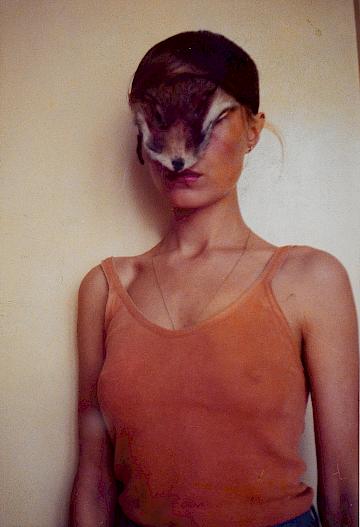 , where the shoulder, arms, and breast can still be seen, make it possible to perceive the process leading up to the final version, in which the entire upper body is covered so that the anthropomorphic reference almost disappears, and the desired transformation into an animal is completed (see also Zebra I, (ph125)
, where the shoulder, arms, and breast can still be seen, make it possible to perceive the process leading up to the final version, in which the entire upper body is covered so that the anthropomorphic reference almost disappears, and the desired transformation into an animal is completed (see also Zebra I, (ph125)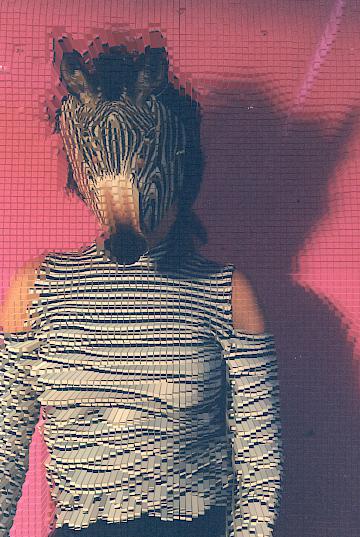 ).
).
Remarkably, the narrative structure in Jürgenssen’s work began to dissolve around 1979/80, as another, entirely different visual world emerged in a positively volcanic way. In January 1981, a catalogue for the exhibition 10 Tage—100 Photos was published in which the face of the artist appears nowhere (s29)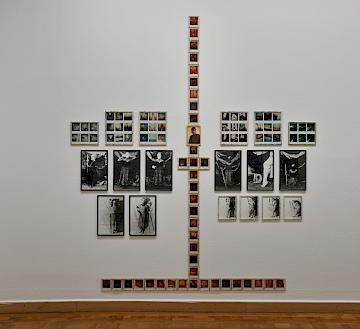 in any of the photographs. Jürgenssen takes the syntax of the face and the female body to the very limits of decipherability. In the Polaroids from the Bad series (Bathing) and the photographs of Konkavspiegel (Concave Mirror, (ph840-850, ph863)
in any of the photographs. Jürgenssen takes the syntax of the face and the female body to the very limits of decipherability. In the Polaroids from the Bad series (Bathing) and the photographs of Konkavspiegel (Concave Mirror, (ph840-850, ph863)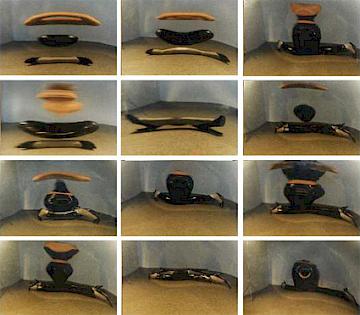 ), the female body is subjected to radical fragmentation and distortion.Discussing these works in an interview, the artist said, “The identity of the woman has been made to disappear—all except for the fetishized object, which is the focus of male fantasy.” 37 Jürgenssen opposed this male perspective by utilizing the strategy of refusal and withdrawal, even though she did not wish to dispense with the quality of sensuality. And so she decided, “As the seduced, I would like to once again seduce, and to create a feeling of sensuality through visualmeans.” 38 There is a sense of oscillation, however, about the disappearance of a self oriented toward legibility, for, as Jürgenssen said, “Whatever we suppress will not tolerate suppression, and it catches up with us again at night.” 39 The legible self that has been made to vanish re-appears, for example, in her Körperprojektionen (Body Projections). Here, the artist projects seductive images, including close-ups of her own face, onto her skin. In his psychoanalytical study, The Skin Ego, Didier Anzieu shows that “the experience of the skin develops an idea of itself as the ego.” 40 In this respect, Jürgenssen’s experience of the Körperprojektionen can be understood as an act in which she becomes aware of her lost self as a skin-self, or skin ego.
), the female body is subjected to radical fragmentation and distortion.Discussing these works in an interview, the artist said, “The identity of the woman has been made to disappear—all except for the fetishized object, which is the focus of male fantasy.” 37 Jürgenssen opposed this male perspective by utilizing the strategy of refusal and withdrawal, even though she did not wish to dispense with the quality of sensuality. And so she decided, “As the seduced, I would like to once again seduce, and to create a feeling of sensuality through visualmeans.” 38 There is a sense of oscillation, however, about the disappearance of a self oriented toward legibility, for, as Jürgenssen said, “Whatever we suppress will not tolerate suppression, and it catches up with us again at night.” 39 The legible self that has been made to vanish re-appears, for example, in her Körperprojektionen (Body Projections). Here, the artist projects seductive images, including close-ups of her own face, onto her skin. In his psychoanalytical study, The Skin Ego, Didier Anzieu shows that “the experience of the skin develops an idea of itself as the ego.” 40 In this respect, Jürgenssen’s experience of the Körperprojektionen can be understood as an act in which she becomes aware of her lost self as a skin-self, or skin ego.
My second thesis is that Jürgenssen situates her oeuvre on the threshold between modernism and postmodernism. Her work unfolds modern concepts of the self (by dint of negating false identities and the act of transgression) as well as postmodern concepts of the self, in which the self as a narrative authority is lost to us under the guidance of deconstruction. Jürgenssen’s plurality of selves, her “identities in transition,” 41 the differences she presents, and her repetitions of the first person singular are taken to such an extreme, in terms of disappearance and doubling, that stability and certainty in the artist’s own identity for a moment seem to occur as if on a “little island.” This “little island” can be located at that place where visual depiction has ceased to occur—such as a blackboard on which the artist wrote in chalk “Ich bin.” (I am.) (s46) in 1995. It might not be a coincidence that, just a few months before, she had produced a facsimile of her school notebook, BICASSO Jürgenssen, seeing as the effect of those two gently written words, “I am.” seems simultaneously fragile and programmatic, just like her first act of artistic territorialization. The extent to which the self-aware-existence of Ich bin. depicts something precarious, however, is expressed by the sponge, a latent reference to the potential for extinction. The title Mit dem Mühlstein um den Hals in das Meer des Vergessens stürzen (Plunging into the Sea of Forgetfulness with a Millstone Around One’s Neck), can also be interpreted as a complaint about the lack of receptivity toward her work. Through her drawings, collages and photographs, and through her thoughts, desires and tenacious criticism, Jürgenssen wanted to be seen and have an impact. In her notebook, she quoted Walter Benjamin with the words, “to live means to leave traces.” In the same place, she also cited Rainer Maria Rilke’s Sonnets to Orpheus:
in 1995. It might not be a coincidence that, just a few months before, she had produced a facsimile of her school notebook, BICASSO Jürgenssen, seeing as the effect of those two gently written words, “I am.” seems simultaneously fragile and programmatic, just like her first act of artistic territorialization. The extent to which the self-aware-existence of Ich bin. depicts something precarious, however, is expressed by the sponge, a latent reference to the potential for extinction. The title Mit dem Mühlstein um den Hals in das Meer des Vergessens stürzen (Plunging into the Sea of Forgetfulness with a Millstone Around One’s Neck), can also be interpreted as a complaint about the lack of receptivity toward her work. Through her drawings, collages and photographs, and through her thoughts, desires and tenacious criticism, Jürgenssen wanted to be seen and have an impact. In her notebook, she quoted Walter Benjamin with the words, “to live means to leave traces.” In the same place, she also cited Rainer Maria Rilke’s Sonnets to Orpheus:
“And when you have been forgotten,
say to the quiet Earth: I flow.
To the rushing water: I am.” 42
1) These three quotations were taken from one of the artist’s many notebooks. All of the notebooks are part of her estate, and are labeled “NbBJ” in the following.
2) Thora Goldschmidt, Français par intuition et images [1909] (Leipzig:Hirt, 1920), pp. 4, 10.
3) Birgit Jürgenssen. Früher oder später, exh. cat. (Linz: Landesgalerie Oberösterreich, 1998), pp. 86, 87.
4) There were class differences, differences between Western and non-Western countries, and differences in autonomous and government-related activities. See Yasmine Ergas, “Der Feminismus der Siebziger Jahre,” in Geschichte der Frauen. 20. Jahrhundert, Georges Duby, Michelle Perrot, eds., vol. 5 (Frankfurt am Main: Fischer, 1997), pp. 559–600.
5) Beate Söntgen, “HannahWilke Superstar,” in HELD TOGETHER WITH WATER. Kunst aus der Sammlung Verbund, ed. Gabriele Schor, exh. cat. (Ostfildern: Hatje Cantz, 2007), pp. 144–50.
6) Peter Weibel, “Birgit Jürgenssen oder Körper-Kunst wider die Semiotik desKapitals,” in Linz 1998 (see note 3), pp. 83–85.
7) Rosalind Krauss, “The Originality of the Avant-Garde and Other Modern Myths” (Cambridge, MA: MIT, 1986), p. 9 and p. 158.
8) Weibel 1998 (see note 6), pp. 83–85.
9) I would like to thank Melanie Wagner, who gave me access to this source.
10) Simone de Beauvoir, Le deuxième sexe [1949]; published in English as The Second Sex (New York:Knopf, 1953).This quote is translated from the German edition Das andere Geschlecht. Sitte und Sexus der Frau (Hamburg: Rowohlt, 1968), p. 398. A new, revised English translation of The Second Sex is expected in 2010.
11) Birgit Jürgenssen in conversation with Doris Linda Psenicnik, Vienna, December 21, 1998 (Estate of Birgit Jürgenssen). I am grateful to Doris Linda Psenicnik for generously allowing me access to the manuscript of the interview.
12) Michel Foucault,Was ist Kritik? [1978] (Berlin:Merve, 1992), p. 12.
13) Birgit Jürgenssen, “‘Alles fliesst, bedingt und durchdringt einander.’ Ein Gespräch mit Felicitas Thun-Hohenstein,” in Carola Dertnig and Stefanie Seibold, eds. let’s twist again.Was man nicht denken kann, das soll man tanzen. Performance in Wien von 1960 bis heute (Vienna: D. E. A., 2006), pp. 272–79.
14) NbBJ (see note 1).
15) Judith Butler, Körper von Gewicht. Gender Studies (Frankfurt am Main: Suhrkamp, 1997).Originally published in English as Bodies that Matter: On the Discursive Limits of Sex (New York: Routledge, 1993).
16) Rainer Burkard, “Von der Rolle. Gibt es eine weibliche Kunst? Die Ausstellung Female Trouble in München spielt mit Frauenbildern aus 150 Jahren,”Die Zeit ( July 31, 2008), p. 45. See also, Inka Graeve Ingelmann, ed., exh. cat., female trouble. Die Kamera als Spiegel und Bühne weiblicher Inszenierungen (Munich: Pinakothek derModerne, 2008).
17) Birgit Jürgenssen in a conversation with Doris Linda Psenicnik (see note 11).
18) Birgit Jürgenssen, “‘Wie erfährt man sich im Anderen, das Andere in sich?’ Ein Gespräch mit Rainer Metzger,” Kunstforum International, 164 (March–May 2003), pp. 234–47.
19) Hans Peter Duerr, Traumzeit. Über die Grenzen zwischen Wildnis und Zivilisation (Frankfurt amMain: Syndikat, 1978), p. 94.
20) Letter from Birgit Jürgenssen to Doris Linda Psenicnik, Vienna,March 8, 2000 (Estate of Birgit Jürgenssen).
21) Bertolt Brecht: “Fragen eines lesenden Arbeiters,” in Gesammelte Werke. Gedichte 2 (Frankfurt am Main: Suhrkamp, 1967),pp. 656–57. For an English-language version, see http://blog.stenhouse.com/archives/2009/04/10/poetry-friday-a-workerreads-history/.
22) For more on the semantic meaning and interpretation of the word “emancipation,” see the essay by Elisabeth Bronfen in this book, p. 84.
23) Jürgenssen 2003 (see note 18).
24) Ibid.
25) See Gabriele Schor, “Lapislazuli. Das Schwarz der Abstrakten Expressionisten,” in Thomas Zaunschirm, ed., exh. cat., Die Farben Schwarz (Vienna, New York: Springer, 1999), pp. 97–120.
26) Jürgenssen, in conversation with Doris Linda Psenicnik (see note 11).
27) NbBJ (see note 1).
28) Peter Kubelka introduced Birgit Jürgenssen to Mae West at the Filmmuseumin Vienna. Quoted in a conversation between Ramin Schor and Peter Kubelka, spring 2009. See also, “Wien 1976,” in Mae West, Greta Garbo (Munich: Hanser, 1978), pp. 62–66.
29) See “Birgit Jürgenssen in einem Interview mit Heidemarie Seblatnig,” in Heidemarie Seblatnig, ed., Einfach den Gefahren ins Auge sehen. Künstlerinnen im Gespräch (Vienna: Böhlau, 1988), pp. 158–161.
30) Gilles Deleuze, Félix Guattari, Kapitalismus und Schizophrenie. Tausend Plateaus (Berlin:Merve, 1992), p. 431. Available in English as A Thousand Plateaus: Capitalism and Schizophrenia, transl. Brian Massumi (Minneapolis: University of Minnesota Press, 1978).
31) Ibid., p. 325.
32) I am grateful to Brigitte Steger, of the Institute for Modern Japanese Studies at the University of Cambridge, for her explanation of this.
33) NbJB (see note 1).
34) Jürgenssen 2006 (see note 13).
35) Henri Michaux, “Tätowierungen,” in Dichtungen. Schriften I (Frankfurt am Main: Fischer, 1966), p. 85.
36) Jacques Aumont: Du visage au cinéma (Paris: Editions de l’Etoile, 1992), p. 49.
37) Jürgenssen 2003 (see note 18).
38) Birgit Jürgenssen, “Ich beschäftige mich mit Fotografie,” in 2. Internationale Foto-Triennale Esslingen 1992. Erfundene Wirklichkeiten, exh. cat., ed. Manfred Schmalriede and Silke Schmalriede (Stuttgart: Edition Cantz, 1992), p. 109.
39) Birgit Jürgenssen, “The inner Passage,” in The Search Within. Art between Implosion and Explosion, exh. cat. (Geras, New Delhi: Österreichisch-Indische Gesellschaft, 1998), p. 76.
40) Didier Anzieu, Le Moi-peau [1985]; translated here from the German, Das Haut-Ich (Frankfurt am Main: Suhrkamp, 1998), p. 60. Published in English as The Skin Ego (New Haven: Yale University Press, 1989). The artist was particularly interested in the phenomena of surface and depth in relation to the skin. Her library contains the book by Oskar Negt and Alexander Kluge, Geschichte und Eigensinn. Entstehung der industriellenDisziplin aus Trennung und Enteignung (Frankfurt am Main: Suhrkamp, 1993), with the chapter “Das Prinzip Hautnähe, or The First-Hand Principle.”
41) Wolfgang Welsch, “Identität im Übergang,” in idem, ed., Ästhetisches Denken (Stuttgart: Reclam, 1990), pp. 168–200.
42) Quoted in NbBJ (see note 1). See Rainer Maria Rilke, Sämtliche Werke, vol. 1 (Frankfurt am Main: Insel, 1955), p. 771. Jürgenssen’s process of transcending the self also becomes more controversial in light of Ernst Bloch’s philosophy of more open-ended formations of meaning. Bloch begins his philosophical presentation with the following words: I am. But I don’t have myself. And so we are only now just becoming.” See Ernst Bloch, “Zugang. Aus sich heraus,” in idem, ed., Tübinger Einleitung in die Philosophie, vol. 13 (Frankfurt am Main: Suhrkamp, 1977), p. 13.